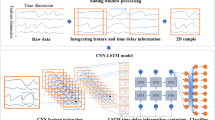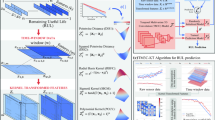Abstract
Automated Fault Detection and Diagnosis (FDD) plays an important role in health monitoring of safety critical systems. Typically, critical industrial processes involve voluminous number of sensors that are capable of assessing the system’s working condition and health. Time series analysis of sensor measurements can be used to predict potential system errors before the damage is irreparable. Predictive analysis is quintessential to reduce the system downtime and the costs associated. A major challenge in FDD is to detect faults much before the full-length time series is available, such that reliable predictions are achieved early in time. Thus, Early Classification of Time Series (ECTS) has to deal with the trade-off between accuracy and earliness, unlike conventional approaches that handle only accuracy. This paper proposes Complex Morlet Wavelet (CMW)-based time–frequency analysis for ECTS in a Deep Learning (DL) framework that combines Convolutional Neural Network (CNN) and Long Short-Term Memory (LSTM) Network. The proposed approach is validated using the publicly available Tennessee Eastman Process (TEP) dataset. Results demonstrate that CMW in combination with hybrid CNN-LSTM architecture outperforms the state-of-the-art approaches for ECTS. The scheme is benefited by the DL architecture that combines CNN and LSTM, rather than these architectures considered individually. The proposed approach is able to achieve superior joint accuracy-earliness optimization when compared to time domain and frequency domain analyses considered separately, conventional Short Time Fourier Transform (STFT)-based time–frequency analysis, and other state-of-the-art time–frequency approaches.
Access this chapter
Tax calculation will be finalised at checkout
Purchases are for personal use only
Similar content being viewed by others
References
A. Gupta, H.P. Gupta, B. Biswas, T. Dutta, Approaches and applications of early classification of time series: a review. IEEE Trans. Artif. Intell. (2020)
Z. Xing, J. Pei, S.Y. Philip, Early prediction on time series: a nearest neighbor approach. in Twenty-First International Joint Conference on Artificial Intelligence (2009)
R.J. Kate, Using dynamic time warping distances as features for improved time series classification. Data Min. Knowl. Discov. 30(2), 283–312 (2016)
J. Hills, J. Lines, E. Baranauskas, J. Mapp, A. Bagnall, Classification of time series by shapelet transformation. Data Min. Knowl. Discov. 28(4), 851–881 (2014)
G. He, W. Zhao, X. Xia, R. Peng, X. Wu, An ensemble of shapelet-based classifiers on inter-class and intra-class imbalanced multivariate time series at the early stage. Soft Comput. 23(15), 6097–6114 (2019)
A. Sharma, S.K. Singh, Early classification of multivariate data by learning optimal decision rules. Multimed. Tools Appl. 1–24 (2020)
H.I. Fawaz, G. Forestier, J. Weber, L. Idoumghar, P.A. Muller, Deep learning for time series classification: a review. Data Min. Knowl. Discov. 33(4), 917–963 (2019)
R. Tavenard, S. Malinowski, Cost-aware early classification of time series. in Joint European Conference on Machine Learning and Knowledge Discovery in Databases (2016), pp. 632–647
U. Mori, A. Mendiburu, E. Keogh, J.A. Lozano, Reliable early classification of time series based on discriminating the classes over time. Data Min. Knowl. Discov. 31, 233–263 (2017)
P. Schafer, U. Leser, TEASER: early and accurate time series classification. Data Min. Knowl. Discov. 34(5), 1336–1362 (2020)
A. Balaji, D.S. Jayanth, H. Ram, B.B. Nair, A deep learning approach to electric energy consumption modeling. J. Intell. Fuzzy Syst. 36(5), 4049–4055 (2019)
M. Ganesan, R. Lavanya, M. Nirmala Devi, Fault detection in satellite power system using convolutional neural network. Telecommun. Syst. 2020, 1–7 (2020)
A. Rajkumar, M. Ganesan, R. Lavanya, Arrhythmia classification on ECG using deep learning. in International Conference on Advanced Computing and Communication Systems (ICACCS) (2019), pp. 365–369
S. Negi, C. Santhosh Kumar, A. Anand Kumar, Feature normalization for enhancing early detection of cardiac disorders. in IEEE Annual India Conference (INDICON) (2016), pp. 1–5
S. Shakya, Process mining error detection for securing the IoT system. J. ISMAC 2(3), 147–153 (2020)
D. Nirmal, Artificial intelligence based distribution system management and control. J. Electron. 2(2), 137–147 (2020)
K. Nakano, B. Chakraborty, Effect of data representation for time series classification-a comparative study and a new proposal. Machine Learn. Knowl. Extract. 1(4), 100–1120 (2019)
H.-S. Huang, C.-L. Liu, V.S. Tseng, Multivariate time series early classification using multi-domain deep neural network. in IEEE 5th International Conference on Data Science and Advanced Analytics (DSAA) (2018), pp. 90–98
E.Y. Hsu, C.-L. Liu, V.S. Tseng, Multivariate time series early classification with interpretability using deep learning and attention mechanism. in Pacific-Asia Conference on Knowledge Discovery and Data Mining (2019), pp. 541–553
M.X. Cohen, A better way to define and describe Morlet wavelets for time-frequency analysis. Neuroimage 199, 81–86 (2019)
A. Sharma, S.K. Singh, A novel approach for early malware detection’. Trans. Emerg. Telecommun. Technol. 32(2), 3968 (2021)
U. Mori, A. Mendiburu, S. Dasgupta, J.A. Lozano, Early classification of time series by simultaneously optimizing the accuracy and earliness. IEEE Trans. Neur. Net. Learn. Sys. 29(10), 4569–4578 (2017)
C.A. Rieth, B.D. Amsel, R. Tran, M.B. Cook, Additional tennessee eastman process simulation data for anomaly detection evaluation. Harvard Dataverse. 2017, 1 (2017)
Author information
Authors and Affiliations
Corresponding author
Editor information
Editors and Affiliations
Rights and permissions
Copyright information
© 2022 The Author(s), under exclusive license to Springer Nature Singapore Pte Ltd.
About this paper
Cite this paper
Gandhimathinathan, A., Lavanya, R. (2022). Early Fault Detection in Safety Critical Systems Using Complex Morlet Wavelet and Deep Learning. In: Ranganathan, G., Fernando, X., Shi, F. (eds) Inventive Communication and Computational Technologies. Lecture Notes in Networks and Systems, vol 311. Springer, Singapore. https://doi.org/10.1007/978-981-16-5529-6_41
Download citation
DOI: https://doi.org/10.1007/978-981-16-5529-6_41
Published:
Publisher Name: Springer, Singapore
Print ISBN: 978-981-16-5528-9
Online ISBN: 978-981-16-5529-6
eBook Packages: EngineeringEngineering (R0)




